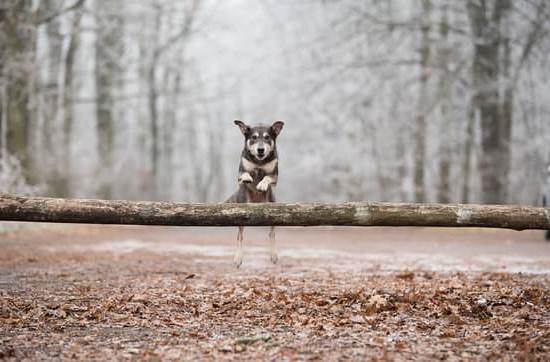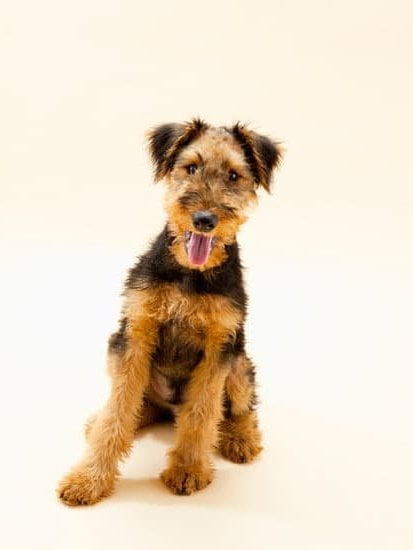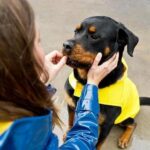Potty training is an essential aspect of raising a well-behaved and housebroken dog. Many pet owners wonder, can dogs be trained to use the bathroom? The answer is yes, dogs can indeed be trained to use the bathroom in a specific area or at certain times.
Potty training not only helps maintain a clean and tidy home but also strengthens the bond between the dog and its owner. In this article, we will explore the process of potty training, including the challenges and benefits associated with it.
Potty training is an important milestone in a dog’s development, as it sets the foundation for good behavior and hygiene. Training a dog to use the bathroom in designated areas not only keeps the home clean but also fosters a sense of responsibility in the pet. However, this process can come with its fair share of challenges, such as accidents and setbacks. It requires patience, consistency, and understanding from dog owners to successfully potty train their furry companions.
In the following sections, we will delve into the specifics of potty training for dogs. This includes understanding when to start potty training, choosing the right methods for training, creating a schedule for bathroom breaks, using training aids effectively, handling accidents with grace and patience, gradually allowing independence in bathroom habits, addressing common challenges that may arise during potty training, and ultimately achieving success in this crucial aspect of canine care.
Understanding Potty Training
Potty training is a crucial aspect of raising a well-behaved and hygienic dog. It involves teaching your canine companion where it is acceptable to relieve themselves, whether it be outdoors or on designated potty pads indoors. Understanding the basics of potty training can help pet owners effectively teach their dogs this essential behavior.
Typical Age for Potty Training:
Dogs can usually begin potty training when they are around 12 to 16 weeks old. At this age, they have enough control over their bladder and bowel movements to start learning proper bathroom etiquette. However, some breeds may take longer to grasp the concept, so it’s important for owners to be patient and consistent with their training efforts.
Positive Reinforcement:
Positive reinforcement is a widely recommended method for potty training dogs. This involves rewarding your furry friend with treats, praise, or affection when they successfully use the designated bathroom area. Positive reinforcement not only encourages good behavior but also establishes a strong bond between the dog and its owner.
- Consider using treats or verbal praise to reward your dog every time they use the bathroom in the designated area.
- Avoid punishing or scolding your dog for accidents as this can create fear and anxiety around bathroom habits.
- Take note of your dog’s schedule and look for cues that indicate they need to go outside or use the potty pad.
Choosing the Right Method
When it comes to potty training your dog, choosing the right method is crucial for success. One common question that many dog owners have is, “Can dogs be trained to use the bathroom?” The answer is yes, with the appropriate training and consistency, dogs can indeed be trained to use the bathroom in a designated spot.
There are several methods that can be used to potty train a dog, and choosing the right one depends on your lifestyle, living situation, and your dog’s individual needs. Crate training is a popular method that utilizes a dog’s natural instinct to keep their den clean.
This involves confining the dog in a crate when unsupervised and taking them outside for bathroom breaks at regular intervals. Paper training, on the other hand, involves teaching the dog to eliminate on a specific surface indoors, such as newspaper or puppy pads.
Regardless of the method chosen, consistency is key. Dogs thrive on routine, so it’s important to establish a consistent schedule for bathroom breaks and stick to it. This helps your furry friend understand when and where they are supposed to do their business. With patience and positive reinforcement, along with choosing the right potty training method for your specific situation, you can successfully train your dog to use the bathroom in an appropriate manner.
| Method | Description |
|---|---|
| Crate Training | Utilizes a dog’s instinct to keep their den clean by confining them in a crate when unsupervised |
| Paper Training | Teaches the dog to eliminate on a specific indoor surface such as newspaper or puppy pads |
Creating a Potty Training Schedule
Establishing a potty training schedule is an essential part of successfully teaching your dog to use the bathroom in the appropriate places. While there is no one-size-fits-all approach to potty training schedules, it is important to consider factors such as the dog’s age, breed, and individual needs.
A general rule of thumb for puppies is to take them outside to eliminate after they wake up, after meals, after playtime, and before bedtime. Adult dogs typically follow a similar schedule.
When creating a potty training schedule, consistency is key. Taking your dog out at the same times every day helps them develop a routine and understand when they are expected to go outside. Additionally, using verbal cues or commands such as “go potty” can help reinforce the behavior you want to encourage.
It’s important to be patient and understanding during the potty training process. Dogs may not grasp the concept immediately, and accidents are inevitable. By consistently following a schedule and providing positive reinforcement when they eliminate in the appropriate place, dogs can be trained to use the bathroom where you want them to. With time and dedication, it is possible for dogs to be trained to use the bathroom effectively and reliably.
Using Training Aids
When it comes to potty training your dog, using training aids such as pee pads and artificial grass can be incredibly helpful. These aids are especially beneficial for puppies or for owners who live in apartments or homes without easy outdoor access. Pee pads, for example, provide a designated spot for your dog to relieve themselves indoors while protecting your floors from accidents.
One of the key benefits of using training aids is that they can help reinforce the intended bathroom behavior. By consistently placing the pee pads or artificial grass in the same location, you are teaching your dog where they should go to use the bathroom. This consistency can expedite the potty training process and reduce accidents around the house.
However, it’s important to note that while training aids can be effective, they should not replace proper potty training methods. They should be used as a supplemental tool to help facilitate the training process. It’s also crucial to regularly clean and replace these aids to prevent your dog from developing undesirable habits. With proper use and maintenance, training aids can significantly contribute to successful potty training for dogs of all ages.
| Training Aid | Benefit |
|---|---|
| Pee Pads | Protects floors from accidents and reinforces designated bathroom area |
| Artificial Grass | Provides an outdoor-like surface for indoor use, helping simulate outdoor bathroom behavior |
Handling Accidents
Immediate Response
Accidents are bound to happen during the potty training process, and it’s important to respond to them calmly and immediately. When you catch your dog in the act of going to the bathroom in the wrong place, simply clap your hands or make a loud noise to startle them. This may interrupt their behavior, allowing you to quickly take them outside to finish their business.
Cleaning Up
It’s crucial to clean up accidents properly to eliminate any lingering odors that may attract your dog back to the same spot. Use a pet-safe cleaner specifically designed for removing urine and feces odors, as this will help discourage your dog from using the same spot again.
Refrain From Punishment
While it can be frustrating to deal with accidents, it’s important not to scold or punish your dog for making a mistake. Punishment can create fear and anxiety, hindering the potty training process rather than helping it. Instead, focus on reinforcing positive behavior and providing ample opportunities for your dog to succeed in using the designated bathroom area.
Remaining Patient
Accidents are a natural part of the learning process for dogs learning where they should go potty. It’s essential for owners to remain patient and understanding throughout this process. Consistency, positive reinforcement, and patience can ultimately lead to successful potty training for even the most challenging of dogs.
Gradual Independence
The process of potty training a dog involves gradually allowing them more independence in their bathroom habits. As the dog becomes more accustomed to the routine and learns where they are supposed to do their business, they can be given increased freedom. This section will discuss the steps involved in this gradual independence and how to recognize when a dog is fully potty trained.
- Establishing Trust: As a dog becomes consistently successful in their potty training, trust is built between the owner and the pet. This trust allows for more freedom and less supervision during bathroom breaks.
- Expanding Boundaries: Initially, dogs may be confined to a specific area for potty training purposes. As they demonstrate reliability in using the designated spot, owners can gradually expand their boundaries within the home.
- Outdoor Access: Once a dog is consistently using an outdoor bathroom spot, they can be given access to this area without constant supervision. This provides them with greater independence and allows them to fulfill their natural instincts without restriction.
It is important for owners to observe their dog’s behavior closely during this transition phase and provide positive reinforcement for correct potty habits. Additionally, if accidents occur, it’s essential to remain patient and continue with consistent training methods.
Overall, gradual independence in potty training signifies that the dog has learned appropriate bathroom behaviors and can be trusted to handle these needs independently. This milestone is a significant achievement in the potty training process.
Ultimately, it’s important for owners to recognize when their dog is fully potty trained. Signs of full potty training may include indicating when they need to go outside or using a specific signal to communicate their need to relieve themselves. By achieving full independence in this area, both the dog and owner can enjoy a harmonious relationship based on trust and understanding.
Common Challenges and Solutions
Dealing With Marking and Territorial Behavior
One common challenge that dog owners may face during potty training is the issue of marking and territorial behavior. This often occurs in male dogs, but can also be seen in females. Marking behavior involves a dog urinating on vertical surfaces as a way of marking their territory.
This can be frustrating for pet owners, especially if the dog continues to do so even after being potty trained. One solution to this is to have the dog spayed or neutered, as this can often reduce or eliminate marking behavior. Additionally, providing ample opportunities for outdoor exploration and exercise can help decrease territorial tendencies.
Overcoming Anxiety and Fear
Some dogs may exhibit anxiety or fear when it comes to bathroom habits, especially if they have had negative experiences in the past. This can lead to difficulties in potty training and may result in accidents indoors. In such cases, it’s important for pet owners to approach the training process with patience and understanding.
Creating a calm and safe environment for the dog during bathroom breaks can help alleviate their anxiety. Gradual desensitization through positive reinforcement techniques can also help the dog feel more comfortable with the potty training process.
Addressing Stubbornness
Stubbornness is another common challenge encountered during potty training. Some dogs may simply resist the training methods being used, making it a frustrating experience for both the owner and the pet. In such cases, it’s imperative for pet owners to remain patient and consistent with their approach.
Changing some aspects of the training routine or incorporating different positive reinforcement techniques can sometimes make a difference in breaking through stubborn behavior. Seeking guidance from professional trainers
By understanding these common challenges and implementing appropriate solutions, pet owners In conclusion, potty training is an essential aspect of caring for a dog, and it is indeed possible to train dogs to use the bathroom. Understanding the typical age for potty training and utilizing positive reinforcement are key elements in this process. Choosing the right method, establishing a consistent schedule, and using training aids can all contribute to successful potty training. It’s important to remain patient and positive, especially when accidents occur, as handling them with grace can make a significant difference in the dog’s learning process. As with any type of training, consistency is crucial in potty training. Creating a routine for bathroom breaks and gradually allowing the dog more independence are steps that ensure lasting success. Even when faced with common challenges like marking or territorial behavior, there are practical solutions and tips to help overcome them. With dedication and persistence, dogs can be trained to use the bathroom effectively and efficiently. In closing, staying patient and consistent in potty training efforts can lead to a positive and rewarding experience for both the dog and the owner. By understanding the process, implementing proper techniques, and addressing challenges as they arise, pet owners can successfully teach their dogs to use the bathroom in appropriate places. This not only fosters good habits but also strengthens the bond between human and canine companions. Yes, dogs can be fully potty trained with consistency, patience, and positive reinforcement. By establishing a routine and teaching them where to eliminate, most dogs can learn to do their business outside or on pee pads indoors. Absolutely, it is possible to train a dog where to pee by using crate training, frequent potty breaks, and rewards for going in the right spot. Consistency is key, as well as finding a designated area for them to use. Yes, there have been instances of dogs being trained to use a toilet. This involves gradually transitioning them from going outside or on pee pads to using the toilet bowl itself. It requires a lot of time and effort but can be done with the right training techniques. Welcome to the blog! I am a professional dog trainer and have been working with dogs for many years. In this blog, I will be discussing various topics related to dog training, including tips, tricks, and advice. I hope you find this information helpful and informative. Thanks for reading!Frequently Asked Questions
Can Dogs Be Fully Potty Trained?
Can You Train a Dog Where to Pee?
Has a Dog Ever Been Trained to Use a Toilet?






